| Srl | Item |
| 1 |
ID:
177817
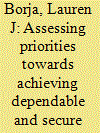

|
|
|
|
|
| Summary/Abstract |
This paper is an assessment of cybersecurity principles within the nuclear arsenal of the United States, specifically the nuclear-armed intercontinental ballistic missile forces. Ongoing modernizations will introduce new components, and potentially new vulnerabilities, into U.S. nuclear forces. The principles for achieving secure operations from the fields of computer security, dependable computing, and systems analysis, and the extent to which they are addressed within the management of U.S. nuclear intercontinental ballistic missiles is discussed. This paper then considers the types of vulnerabilities that may be overlooked during modernizations, followed by a critique of U.S. nuclear command and control policy choices that could make the consequences of these vulnerabilities more catastrophic.
|
|
|
|
|
|
|
|
|
|
|
|
|
|
|
|
| 2 |
ID:
129938
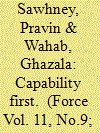

|
|
|
| 3 |
ID:
103847
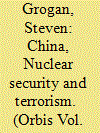

|
|
|
|
|
| Publication |
2009.
|
| Summary/Abstract |
This article outlines Chinese strategic nuclear forces and the Chinese philosophical approach to nuclear security. It then focuses on the domestic conditions in China which could precipitate vulnerabilities to its nuclear forces. From information about internal security conditions in China, specific internal threats to Chinese nuclear security will be derived. Based on these threats, several outsider and insider scenarios will be outlined involving a variety of terrorist or terrorist related behaviors. These notional scenarios will include everything from overrun or attack, to diversion, to cyber terrorism, to sabotage. The article will then cover what these scenarios and the possible Chinese reaction to them may mean for the security, military and diplomatic strategies of the United States
|
|
|
|
|
|
|
|
|
|
|
|
|
|
|
|
| 4 |
ID:
116300
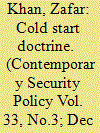

|
|
|
|
|
| Publication |
2012.
|
| Summary/Abstract |
A reaction by the Indian military to a series of violent crises with Pakistan, beginning with the Kargil conflict of 1999, Cold Start Doctrine (CSD) envisions limited attacks on Pakistan territory as non-nuclear retaliation against asymmetric and proxy attacks. Cold Start Doctrine and Pakistani responses show that the South Asian region is still adjusting to the consequences of overt nuclearization in 1998. India and Pakistan remain prone to arms racing and vulnerable to destablization. CSD is part of an action-reaction process, increasing risks of war and the risk that nuclear weapons would be used should war occur. It worsens the natural tension between India's desire for resolution through conventional conflict and Pakistan's declared willingness to escalate to nuclear first use. For India, CSD increases incentives to abandon its previous commitment to nuclear No First Use. Probable Pakistani responses include development of tactical nuclear weapons, forward deployment of nuclear forces, and pre-delegation of launch authority, increasing its problems of force protection, command and control, and escalation control. This article concludes, based on reliable sources, that neither of these war-like strategies benefits the two nuclear rivals as each state's policy options confront certain issues that invite strategic instability in South Asian region and should be reconsidered.
|
|
|
|
|
|
|
|
|
|
|
|
|
|
|
|
| 5 |
ID:
052909
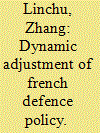

|
|
|
| 6 |
ID:
175888
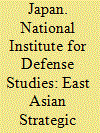

|
|
|
|
|
| Publication |
Tokyo, National Institute For Defense Studies, 2020.
|
| Description |
x, 217p.Pbk
|
| Standard Number |
9784864820844
|
|
|
|
|
|
|
|
|
|
|
|
Copies: C:1/I:0,R:0,Q:0
Circulation
| Accession# | Call# | Current Location | Status | Policy | Location |
| 059919 | 355.0095/JAP 059919 | Main | On Shelf | General | |
|
|
|
|
| 7 |
ID:
154210
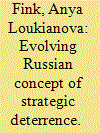

|
|
|
|
|
| Summary/Abstract |
Over the last decade, Russia has been putting into operation its vision of strategic deterrence, a doctrinal approach built on a demonstrated spectrum of capabilities and a resolve to use military force. Russia’s strategic deterrence is conceptually different from its Western namesake in that it is not limited to nuclear weapons.
|
|
|
|
|
|
|
|
|
|
|
|
|
|
|
|
| 8 |
ID:
123547
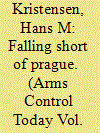

|
|
|
| 9 |
ID:
042741
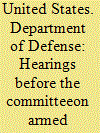

|
|
|
|
|
| Publication |
Washington, U.S. Govt. printing office, 1982.
|
| Description |
vi, 507p.
|
|
|
|
|
|
|
|
|
|
|
|
Copies: C:1/I:0,R:0,Q:0
Circulation
| Accession# | Call# | Current Location | Status | Policy | Location |
| 022920 | 355.0217/USA 022920 | Main | On Shelf | General | |
|
|
|
|
| 10 |
ID:
123559
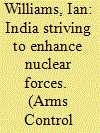

|
|
|
| 11 |
ID:
046178
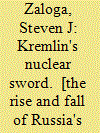

|
|
|
|
|
| Publication |
Washington, Smithsonian Institution Press, 2002.
|
| Description |
viii, 296p.
|
| Standard Number |
1588340074
|
|
|
|
|
|
|
|
|
|
|
|
Copies: C:1/I:0,R:0,Q:0
Circulation
| Accession# | Call# | Current Location | Status | Policy | Location |
| 046047 | 355.02170947/ZAL 046047 | Main | On Shelf | General | |
|
|
|
|
| 12 |
ID:
192701
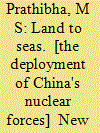

|
|
|
|
|
| Publication |
New Delhi, MP-IDSA, 2023.
|
| Description |
102p.pbk
|
| Series |
MP-IDSA Monograph Series; 83
|
| Standard Number |
9788196508050
|
|
|
|
|
|
|
|
|
|
|
|
Copies: C:2/I:0,R:0,Q:0
Circulation
| Accession# | Call# | Current Location | Status | Policy | Location |
| 060474 | 355.0217/PRA 060474 | Main | On Shelf | General | |
| 060475 | 355.0217/PRA 060475 | Main | On Shelf | General | |
|
|
|
|
| 13 |
ID:
150296
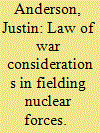

|
|
|
|
|
| Summary/Abstract |
The status of nuclear weapons within international law was a subject of intense debate during last fall’s UN General Assembly First Committee session. State supporters of the humanitarian initiative on nuclear weapons pressed for resolutions asserting the illegality of nuclear weapons and sought to build support for the near-term negotiation of a global ban on nuclear arsenals.
|
|
|
|
|
|
|
|
|
|
|
|
|
|
|
|
| 14 |
ID:
087072
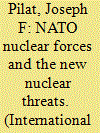

|
|
|
|
|
| Publication |
2008.
|
| Summary/Abstract |
The North Atlantic Treaty Organization's nuclear forces were central to deterence and defence duting the Cold War. Their future role is far less clear in the dramatically changed security environment since its end. Dispite concerns about the long term evolution of Russia and China, the major threats to national and international security today stem not from confrontations between great powers, but from proliferation and terrorism.
|
|
|
|
|
|
|
|
|
|
|
|
|
|
|
|
| 15 |
ID:
104089
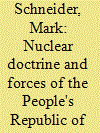

|
|
|
|
|
| Publication |
2009.
|
| Summary/Abstract |
The People's Republic of China is the only member of the P-5 that is increasing both the quantity and quality of its nuclear forces. This nuclear buildup is in the context of military buildup that growing faster than any nation in the world. The China buildup is aimed a providing it a capability to dominate the Far East. The U.S. is regarded as main enemy and Chinese preparations are aimed at fight a major war against the United States.
|
|
|
|
|
|
|
|
|
|
|
|
|
|
|
|
| 16 |
ID:
125381
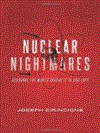

|
|
|
|
|
| Publication |
New York, Columbia University Press, 2013.
|
| Description |
266p.
|
| Standard Number |
9780231164047
|
|
|
|
|
|
|
|
|
|
|
|
Copies: C:1/I:0,R:0,Q:0
Circulation
| Accession# | Call# | Current Location | Status | Policy | Location |
| 057543 | 327.1747/CIR 057543 | Main | On Shelf | General | |
|
|
|
|
| 17 |
ID:
091458
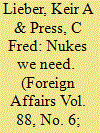

|
|
|
|
|
| Publication |
2009.
|
| Summary/Abstract |
The Obama administration is right that the United States can safely cut some of its nuclear arsenal, but it must retain the right capabilities. Otherwise, the United States' adversaries might conclude -- perhaps correctly -- that Washington's nuclear strategy rests largely on a bluff.
|
|
|
|
|
|
|
|
|
|
|
|
|
|
|
|
| 18 |
ID:
054577
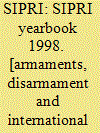

|
|
|
|
|
| Publication |
Oxford, Oxford University Press, 1998.
|
| Description |
xxxiv, 638p.hbk
|
| Series |
SIPRI Yearbook
|
| Standard Number |
0198294549
|
|
|
|
|
|
|
|
|
|
|
|
Copies: C:2/I:0,R:0,Q:0
Circulation
| Accession# | Call# | Current Location | Status | Policy | Location |
| 040190 | 327.17405/SIP 040190 | Main | On Shelf | General | |
| 040684 | 327.17405/SIP 040684 | Main | On Shelf | General | |
|
|
|
|
| 19 |
ID:
060123
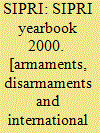

|
|
|
|
|
| Publication |
Oxford, Oxford University Press, 2000.
|
| Description |
xiii, 758p.hbk
|
| Series |
SIPRI Yearbook 2000
|
| Standard Number |
0199241627
|
|
|
|
|
|
|
|
|
|
|
|
Copies: C:1/I:0,R:0,Q:0
Circulation
| Accession# | Call# | Current Location | Status | Policy | Location |
| 043451 | 327.17405/SIP 043451 | Main | On Shelf | General | |
|
|
|
|
| 20 |
ID:
144650
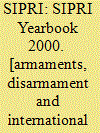

|
|
|
|
|
| Publication |
Oxford, Oxford University Press, 2000.
|
| Description |
xlii, 758p.hbk
|
| Series |
SIPRI Yearbook 2000
|
| Standard Number |
0199241627
|
|
|
|
|
|
|
|
|
|
|
|
Copies: C:1/I:0,R:0,Q:0
Circulation
| Accession# | Call# | Current Location | Status | Policy | Location |
| 043575 | 327.17405/SIP 043575 | Main | On Shelf | General | |
|
|
|
|